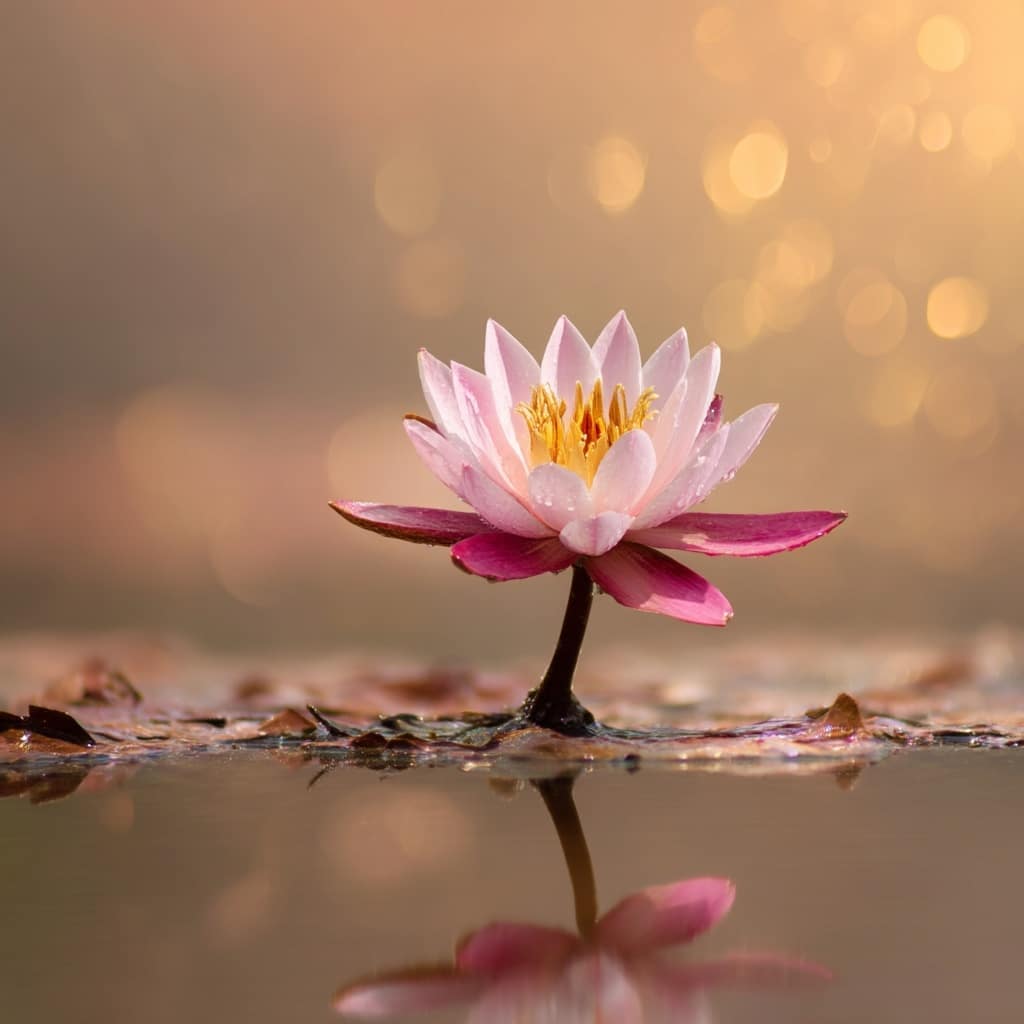Lotus flower stands as one of nature’s most sacred symbols — representing purity, rebirth, and spiritual awakening. Rising gracefully from murky waters, it embodies the beauty of transformation, showing that even in the darkest environments, light and purity can bloom. This remarkable plant has inspired spiritual traditions, art, and culture for thousands of years, from ancient Egypt to Buddhism and Hinduism.
The lotus flower’s unique ability to stay unstained despite its muddy surroundings mirrors the human journey of rising above challenges while maintaining inner peace and integrity. Each color of the lotus carries a distinct meaning, reflecting emotions, virtues, and states of enlightenment. Beyond its spiritual symbolism, the lotus flower also serves practical purposes — from medicine and cuisine to garden beauty.
Its enduring presence across cultures reminds us that true growth comes from within, and that beauty can thrive even where others see only mud.
Table of Contents
History of the Lotus Plant
The lotus flower has been admired and revered since ancient times, holding a sacred place in cultures around the world. Its story begins thousands of years ago, where it was celebrated as a symbol of creation, purity, and divine beauty. Across ancient civilizations, the lotus was more than just a plant — it represented the eternal cycle of life, death, and rebirth.
Ancient Egypt
In ancient Egyptian mythology, the lotus flower symbolized the sun and creation. Egyptians observed how the lotus closed its petals at night and reopened with the sunrise — a sign of renewal and rebirth. It was believed that the lotus gave birth to the sun god Ra, making it one of the most powerful symbols of creation. The flower appeared frequently in temple carvings, art, and sacred texts as a representation of life emerging from the dark waters of chaos.
Asia and the East
In Asia, the lotus became an emblem of spiritual growth and enlightenment. In India, it is deeply connected to deities like Lakshmi and Brahma, symbolizing purity and divine energy. In Buddhism, the lotus is a central image representing the soul’s journey toward enlightenment — from the muddy waters of ignorance to the bloom of wisdom and compassion.
Other Cultures
The Chinese view the lotus as a symbol of purity and harmony, often linking it to moral virtues and marital happiness. In Japanese culture, the lotus represents perseverance and inner strength, while in Greek and Roman mythology, it symbolizes peace and tranquility.
Throughout history, the lotus flower has transcended cultural boundaries — serving as a reminder that no matter where one starts, purity and awakening are always within reach.
Symbolism of Lotus Flowers

The lotus flower carries a universal symbolism that transcends culture and religion. Emerging pure and beautiful from muddy waters, it embodies transformation, purity, and spiritual elevation. Its journey from darkness to light mirrors the human spirit’s path toward awakening, resilience, and self-realization.
Spiritually, the lotus flower teaches that beauty can arise from struggle — that even in the murkiest conditions, one can remain untouched and radiant. This symbolic purity has made the lotus a sacred emblem in philosophy, art, and spiritual teachings across centuries.
Purity and Enlightenment
Because the lotus flower blooms above murky waters without getting stained, it is seen as a powerful symbol of purity and enlightenment. It reminds us to rise above negativity, just as the flower rises above the mud. In Buddhism, it represents the clarity of mind and spirit achieved through meditation and self-awareness.
Rebirth and Transformation
The lotus closes at night and reopens with the morning light, symbolizing rebirth and new beginnings. This natural rhythm of the flower is a metaphor for the soul’s cycle — falling into darkness only to emerge renewed. Many spiritual traditions see the lotus as a reminder that no matter how many times we fall, we can always rise again stronger and wiser.
Spiritual Growth
Each stage of the lotus flower’s growth — from bud to full bloom — represents stages of spiritual evolution. A closed bud symbolizes potential and innocence, while a fully bloomed lotus signifies enlightenment and awakening. Its ability to grow in adverse conditions reminds us that spiritual growth often begins in life’s most challenging moments.
Detachment and Peace
Despite growing in muddy waters, the lotus flower remains clean and untarnished, representing detachment from the impurities of the world. Spiritually, this reflects a state of inner peace and balance — living among chaos while staying pure at heart. It encourages us to rise above emotional disturbances and maintain serenity within.
Lotus Flowers Meaning — Symbolism of Each Color

Each color of the lotus flower carries its own unique symbolism, expressing different spiritual emotions, virtues, and states of consciousness. From pure white to radiant blue, each hue tells a story about growth, divinity, and the many paths toward enlightenment. Understanding these color meanings allows us to connect more deeply with the lotus’s spiritual energy.
White Lotus Flower Meaning
The white lotus flower represents purity, peace, and spiritual perfection. It’s often associated with enlightenment and the divine self — the ultimate state of clarity and inner truth. In Buddhism, the white lotus is linked with the awakening of the spirit, symbolizing a pure heart untainted by worldly desires. Placing white lotus blooms in meditation or home spaces brings calmness, balance, and mental purity.
Pink Lotus Flower Symbolism
The pink lotus flower holds the highest spiritual significance in many traditions, especially Buddhism, where it represents the supreme state of enlightenment. It is closely connected to divine figures like Buddha and symbolizes love, compassion, and the realization of one’s true nature. A blooming pink lotus is often a sign of a heart opening to unconditional love and spiritual truth.
Purple Lotus Flower Meaning
The purple lotus stands for mysticism, insight, and higher spiritual understanding. It is often depicted with multiple petals, representing the unfolding of spiritual awareness. The purple lotus encourages introspection and the pursuit of wisdom, guiding seekers to connect with their inner intuition. It’s a favorite symbol for meditation and mindfulness practices.
Red Lotus Flower Symbolism
The red lotus flower embodies love, compassion, and devotion. It is the symbol of the heart — representing the purity of emotions and the deep connection between humanity and the divine. Spiritually, it signifies the awakening of passion balanced with wisdom. In Buddhist art, the red lotus is often seen as the flower of Avalokiteshvara, the Bodhisattva of Compassion.
Blue Lotus Flower Meaning
The blue lotus flower symbolizes knowledge, wisdom, and spiritual control. Unlike other flowers that bloom toward the sun, the blue lotus opens with the dawn and closes at dusk, representing the constant search for truth. In ancient Egypt, it was associated with the sun and rebirth, while in Buddhism, it reflects mastery over desires and the triumph of mind over emotions.
Yellow Lotus Flower Meaning
The yellow lotus radiates joy, positivity, and spiritual energy. It’s often linked to creativity and enlightenment through optimism. This vibrant bloom encourages open-mindedness and a sunny outlook on life. Spiritually, it inspires personal transformation through light-hearted awareness and gratitude.
Cultural Significance of Lotus Flowers

The lotus flower has deep cultural roots that span continents, religions, and centuries. Its symbolism of purity, enlightenment, and rebirth has made it one of the most recognized and sacred plants across the world. Whether in temples, art, or traditional rituals, the lotus represents the harmony between the spiritual and natural worlds.
Lotus in Hinduism
In Hindu culture, the lotus holds divine status. It is often associated with gods and goddesses like Vishnu, Lakshmi, and Saraswati, who are frequently depicted sitting or standing on lotus blooms. The lotus flower symbolizes divine creation, purity, and prosperity, representing the unfolding of the soul. The Sanskrit word for lotus, Padma, appears in sacred texts, symbolizing spiritual awakening and the expansion of consciousness.
Lotus in Buddhism
In Buddhism, the lotus is one of the Eight Auspicious Symbols, representing enlightenment and liberation. Its journey from mud to bloom mirrors the soul’s path from ignorance to spiritual awakening. Each color of the lotus flower in Buddhist teachings has distinct meaning — for instance, the pink lotus is connected to Buddha himself, while the white lotus represents spiritual purity.
Many Buddhist temples feature lotus ponds, encouraging meditation on serenity and mindfulness.
Lotus in Ancient Egypt
In ancient Egyptian culture, the lotus flower symbolized creation, the sun, and rebirth. Egyptians believed that the lotus gave birth to the sun god Ra, rising each morning from the waters of chaos. The blue lotus, in particular, was sacred and often used in spiritual ceremonies, art, and tomb decorations to represent eternal life and resurrection.
Lotus in Chinese Tradition
In Chinese culture, the lotus flower is admired as a symbol of purity, virtue, and perfection. It represents the harmony between beauty and resilience, as it grows unstained from muddy waters. The lotus is also associated with marital happiness and integrity — often featured in art and poetry to symbolize noble character and loyalty.
Lotus in Japanese Symbolism
In Japan, the lotus flower is revered as a symbol of spiritual growth and perseverance. It embodies the Buddhist idea that enlightenment can emerge from the struggles of life. The blooming lotus in Japanese art often represents the triumph of wisdom over ignorance, and the beauty of maintaining grace amid adversity.
Biblical, Religious, and Spiritual Meanings of the Lotus Flower

While the lotus flower is not directly mentioned in the Bible, its symbolism aligns closely with spiritual themes found in many religions — purity, rebirth, and divine awakening. The flower’s emergence from murky waters into a perfect bloom mirrors the human soul’s journey toward enlightenment and redemption.
Spiritual Symbolism
Spiritually, the lotus flower represents the awakening of the inner self — the point where consciousness rises above material desires and emotional struggles. Its petals unfolding one by one symbolize layers of awareness opening toward truth and spiritual clarity.
In meditation, the lotus is often visualized as a sacred seat of energy (the lotus of the heart), representing purity, love, and peace.
Biblical Parallels
Though not a native plant to the Middle East, the lotus flower is often compared to the lily, which holds similar biblical meaning. In Christianity, the lily represents purity, resurrection, and divine grace — qualities also embodied by the lotus.
The story of rising from darkness into light parallels the Christian belief in renewal through faith and the promise of eternal life.
Lotus in Other Spiritual Paths
- Hinduism: The lotus is a sacred symbol of spiritual creation and enlightenment. The crown chakra (Sahasrara) is represented by a thousand-petaled lotus, signifying connection to divine consciousness.
- Buddhism: It represents the path to enlightenment, purity of speech, mind, and body, and the detachment from earthly attachments.
- Egyptian Beliefs: The lotus was seen as the origin of all life, linked to the rising sun and rebirth after death.
- New Age Spirituality: The lotus is used as a symbol for personal transformation and awakening, reminding individuals to rise above negativity and evolve into their higher selves.
The lotus flower unites faiths and philosophies through its message of hope — showing that beauty and light can always emerge, no matter how muddy the path may seem.
Uses of Lotus Plants

Beyond its deep spiritual and cultural symbolism, the lotus flower has numerous practical uses that make it both beautiful and beneficial. From ornamental gardening to culinary and medicinal applications, every part of the lotus — from its petals to its roots — serves a purpose. Its versatility has earned it a special place in both traditional and modern lifestyles.
Ornamental and Garden Use
The lotus flower is a stunning addition to ponds and water gardens, admired for its large, fragrant blooms and vibrant colors. Its ability to thrive in still or slow-moving water makes it ideal for creating tranquil, meditative spaces.
Lotus plants also attract beneficial insects, such as bees and butterflies, enhancing the biodiversity of a garden. In landscaping, they symbolize peace and purity, often featured in Zen gardens, temple ponds, and serene courtyards.
Culinary Uses
Many parts of the lotus plant are edible and used in Asian cuisines.
- The lotus root (rhizome) is a popular ingredient, known for its crisp texture and mild flavor. It is commonly stir-fried, steamed, or added to soups.
- Lotus seeds are roasted, boiled, or made into pastes used in desserts and traditional sweets.
- Young leaves and stems can also be eaten raw or cooked, adding freshness and nutrition to meals.
Nutritionally, the lotus is rich in fiber, vitamins, and antioxidants — promoting good digestion and overall health.
Medicinal Uses
In traditional medicine, especially Ayurveda and Chinese herbal medicine, the lotus flower is valued for its healing properties.
- Lotus leaves are used to calm the mind and support heart health.
- Lotus seeds are believed to improve sleep, reduce stress, and promote vitality.
- Lotus roots are known for cooling the body and aiding in detoxification.
These holistic uses show how the lotus bridges the gap between spiritual wellness and physical health.
Cultural and Artistic Uses
The lotus flower is also a timeless motif in art, architecture, and design. Its elegant form appears in temple carvings, paintings, and jewelry, symbolizing divine beauty and serenity. Even today, it remains a source of inspiration for spiritual tattoos, home décor, and mindful living spaces — reflecting peace, growth, and inner awakening.
Conclusion

The lotus flower stands as a timeless reminder of purity, resilience, and spiritual awakening. Its journey from murky waters to radiant bloom mirrors our own path toward growth and enlightenment. No matter how difficult life’s circumstances may be, the lotus teaches that beauty and grace can emerge from even the darkest places.
Each color of the lotus tells a different story — from the white flower’s divine purity to the pink bloom’s spiritual enlightenment and the blue lotus’s quest for wisdom. Its deep roots in culture, religion, and healing practices show that this extraordinary plant is much more than a symbol — it’s a living embodiment of balance between the body, mind, and spirit.
To meditate beside a lotus flower or simply admire its serene beauty is to remember one of nature’s greatest lessons: peace begins when we rise above the mud and open ourselves to the light.


